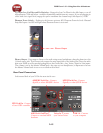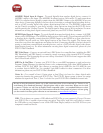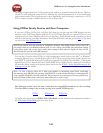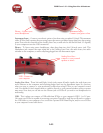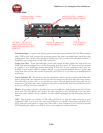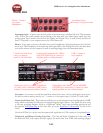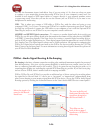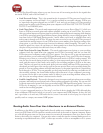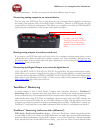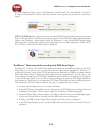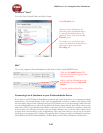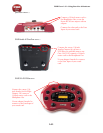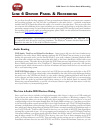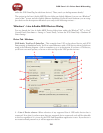
POD Farm 1.01 – Using Your Line 6 Hardware
2•27
In the PODxt Signal Routing selector you can choose one of four routing modes for the signals that
run inside PODxt, and to Record Send 1-2:
Send Processed Guitar• - This is the normal mode of operation: PODxt-processed sound is sent
to your computer via Record Send 1-2 so it can be recorded in your audio software. PODxt gets
its input from the guitar plugged into its INPUT jack, and you can listen to PODxt-processed
guitar sound as well as sound coming from your computer via PODxt’s LEFT OUTPUT, RIGHT
OUTPUT and PHONES jacks.
Send Clean Guitar• - This mode sends unprocessed guitar to your to Record Send 1-2, while you
listen to PODxt-processed guitar and software playback coming out of your PODxt. You can use
this to record an unprocessed guitar signal in your audio software for later re-amping, while hearing
your PODxt-processed guitar signal without latency being added by your recording program. You
can then choose USB Signal Routing modes 3 and 4 when you’re ready to playback that track
and re-amp it through your PODxt. You may also want to record a copy of your PODxt-processed
sound from the analog outputs of your PODxt when you are making your digital recording of the
clean guitar, so you have the processed version for reference when re-amping. This track is also
handy for punch-ins, since you can listen to it during punch-ins to hear the processed version of
the part of the previously recorded track that you want to keep.
Send Clean Guitar Re-Amp Playback• - This mode sends unprocessed guitar to your recording
software, feeds the signal from your computer into PODxt’s processing, and lets you hear the
PODxt-processed computer sound at PODxt’s outputs. You can use this to run an unprocessed
guitar track that you recorded using USB Signal Routing mode 2 into your PODxt for re-amping,
allowing you to listen to or record the PODxt-processed result via PODxt’s analog outputs. You
can also use this mode during initial recording, so that unprocessed guitar can be recorded to a
track, and the output of that track can be sent by the recording program to PODxt at the same
time. This lets you punch-in on the track while you’re recording, and hear PODxt processing of
the already recorded part of the track as well as the new portion that you’re recording during the
punch-in. Your recording software will add some latency to the guitar signal that it is monitoring
back through to PODxt. You can generally get the lowest latency by reducing your buffer size in
the recording software, but lower buffer settings will utilize more of your computer’s processing,
so you may not be able to run as many tracks or effects in your recording software when you do
this. See your recording software’s instructions for details.
Send Re-Amp Playback• - This mode is designed to receive unprocessed guitar from your recording
program, and send processed guitar back to the recording program for recording. You can use this
to run an unprocessed guitar track that you recorded using USB Signal Routing mode 2 into your
PODxt for re-amping, so you can digitally record the PODxt-processed signal back to another
track in the recording program.
Note – it is not a supported practice to “hot swap” your Line 6 device (unplug the USB cable and plug
it into a different USB device) while it is in use by your computer and DAW software. In fact, this just
isn’t a good idea to do with any USB audio devices, since it can result in a loud pop, loss of sync and
possibly crash or corrupt your current DAW project.
Routing Audio From Your Line 6 Hardware to an External Device
In addition to the ability to route digital audio directly within your computer, you may instead want to
route your POD Farm or POD signal into another sound card on the same or separate computer. Better
yet, with all the great tones you can now create for your mics & instruments, there is no need to limit
them to the inside of a computer! You may also want to send the signal to external hardware such as
an analog or tape Multitrack unit, a DAT or video tape recorder, or even to an amplifier or P.A. system



